The
Home Page Selection
If
you require further information on any
print featured here, please contact
us.
When
a print has been sold it will be marked
as Sold.
A
growing archive of selections
from previous Home pages is featured in
the
Home
Page Selection Archive |
|
See
also :
Click
on a thumbnail (left)
to link directly with the entry for that
print, or scroll down to view all the selected
prints from the current Home
Page.
Images
are not to relative scale (see stated dimensions) and also at only modest resolution.
If you wish to view extracts of an image at higher resolution, please Contact us.
|
|
|
|
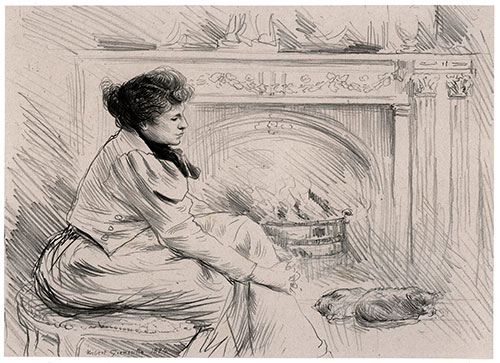
| |
NORBERT GOENEUTTE
Paris 1854 – Auvers-sur-Oise 1894
A student at the Ecole des Beaux Arts in the early 1870’s, Goeneutte, though he did not exhibit with them, was a friend of the Impressionists and influenced by their approach.
Marcellin Desboutin taught him the techniques of etching in the mid-1870’s. Goeneutte was a founder member of the Sociètè des paintres-graveurs français. In 1891 Dr Gachet, an avid supporter of art and himself an amateur artist, recommended Goeneute should move to the countryside for his health and found him a house near his own in Auvers-sur-Oise, the village where Daubigny also had a house. Goeneutte died there only three years later, aged only forty.
Au Coin du Feu
By the fireside
Knyff 107; I.B.N. 81
240 x 334 mm
(papier chine)
Original lithograph 1894.
Signed and dated in the stone.
Second state, after removal of the remarque sketch of a rabbit.
As published by L’Artiste in their album Les Peintres lithographes, 1894.
On pale grey chine appliqué on white wove.
£450
Return to top ^ |
|
|
|
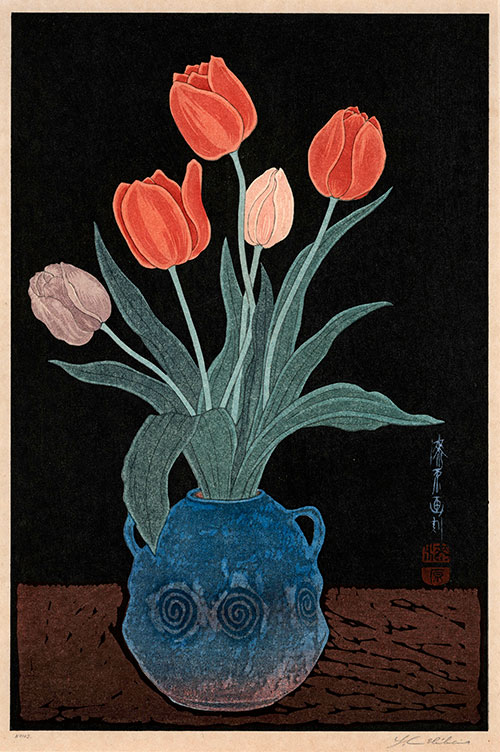
|
|
YOSHIJIRO URUSHIBARA
Shiba, Tokyo 1889 – 1953 Tokyo
Urushibara came to London in 1910, on behalf of his employer, the firm
of the Shimbi Shoin, to demonstrate Japanese woodblock printing at the Japan-British Exhibition
held that year at White City, Shepherds Bush, May-October.
He went on to work at the British Museum first to reproduce a famous Chinese hand scroll and
in restoring and mounting prints. At the B.M. he became friendly with Laurence Binyon and got to know
several British artists, Clausen, Brangwyn &co, collaborating with them, interpreting their paintings into
colour woodcuts.
He also made his own original prints.
Urushibara remained in London till 1940, when he and his family were forced to leave and return to Japan.
Tulips 3
(Tulips in a double-eared vase)
Chapman & Horner F44
304 x 202 mm
Original colour woodcut, signed in pencil and numbered 102 (though the highest number
recorded by Chapman & Horner is 17)
Sold
Urushibara made four prints of tulips, shown in different vases.
The vase in Tulips 3, also appears in one of his prints of Lilies, and also in Freesias & Anemones.
Return to top ^ |
|
|
|
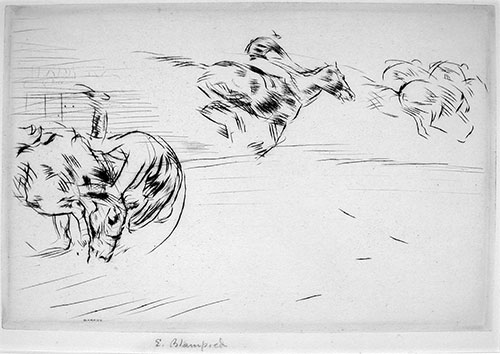 |
|
EDMUND BLAMPIED R.E.
Ville Brée, Jersey 1886 – 1966 St Aubin, Jersey
Blampied grew up in rural Jersey, the son of a farmer, and did not visit a town until he was fifteen,
when he attended his first art lessons in St Helier.
A couple of years later, in 1903, he left the island
to train at Lambeth School of Art.
Though London was his home for many years, particularly those when he was active as an etcher,
much of Blampied’s inspiration was drawn from his memories of Jersey,
especially of working horses, a favourite theme, which he handled with a complete mastery.
His spontaneity lent itself to capturing and expressing the least movement, excellently demonstrated
in The Tumble, a rare image from the world of the race horse.
The Tumble
Campbell Dodgson 61
196 x 297 mm
Original drypoint, 1921.
Signed in pencil.
Edition of 100.
On Whatman wove paper watermarked with the date 1919.
Faintly mount stained.
£550
Return
to top ^ |
|
|
|
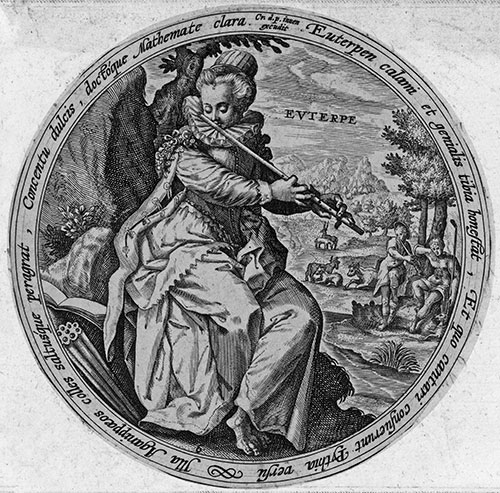 |
|
CRISPIN DE PASSE the Elder
Arnemuiden 1589 – 1637 Utrecht
After his move to Cologne for religious reasons de Passe set up as an independent engraver
and publisher. As they grew up, his three sons and daughter all joined him and were trained
in the family business, before moving to other parts of Europe, including briefly England,
developing an international business.
Amongst his output of decorative cycles was a series of ‘portraits’ of each of The Nine Muses,
the goddesses of creative inspiration in poetry, song and other arts, which de Passe published about 1600. Several
of them show the principal female figure in a classical landscape playing or accompanied by musical instruments,
as in that offered here. Obviously why this print was chosen as a gift for a musician, the conductor Sir Colin Davis.
Euterpe– Muse of Music and Lyric Poetry
Hollstein 408
125 mm diameter
Engraving, c1600.
Plate number 6 of the series of nine Muses.
The plate signed with de Passe’s name and ‘address’.
A fine impression, trimmed to a roundel, close to the borderlines and laid down.
Script verso.
£750
Ex collection Sir Colin Davis (A gift to him from the Orchestra of the Von Müller Gymnasium, Regensburg, 1989)
Terpsichore plays the flute, while in the distant landscape Hermes plays his pipe to lull Argos to sleep.
The surrounding ‘motto’ refers to the sweet harmony of the reed pipe and to Pythian verse.
The quadrennial Pythian Games at Delphi, as well as athletics, comprised musical contests – singing to the lyre,
and cithara and flute playing.
Return
to top ^ |
|
|
|
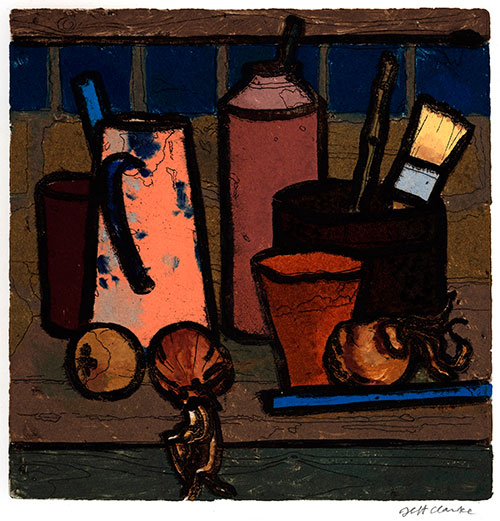 |
|
JEFF CLARKE R.E.
Born Brighton 1935
A practicing painter and etcher, Jeff is also an organist and singer.
Pink Jug and Onions is his latest colour print.
A wider retrospective selection of his work is shown in the web exhibition elsewhere on my website.
Pink Jug and Onions
265 x 262 mm
Original sugar aquatint and added oil colours, 2021.
Signed in pencil.
Sold
Return
to top ^ |
|
|
|
|
|
|
|